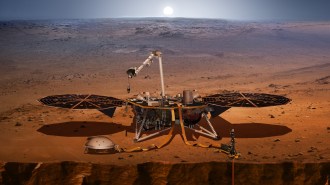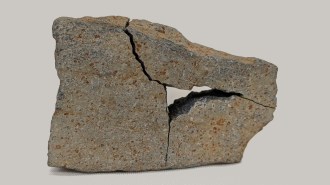A Tale of Two Landers: NASA’s Spirit phones home, but Europe’s Beagle 2 remains mum on Mars


NASA’s latest emissary to Mars, the rover called Spirit, triggered cheers and high fives among mission members when it sent its first signals home soon after touching down on the Red Planet on Jan. 3. In stark contrast, somber but hopeful scientists with the European Space Agency haven’t yet heard from their Beagle 2 lander, which dropped to the Martian surface on Dec. 24, 2003.
Spirit’s lander descended into the 150-kilometer-wide Gusev crater about 15 south of the Martian equator. The flat, dusty locale (see panoramic view above) is littered with rocks up to 20 centimeters across. The scientists expect that terrain to be easily traversable once the 174-kilogram, golf cart-size rover begins moving during the upcoming week.
Meanwhile, NASA scientists are performing equipment checks and analyzing images to develop Spirit’s itinerary. Air temperatures at the landing site range between –70C and 0C, and the images that have reached Earth suggest windy weather: Many rocks appear to have been sandblasted smooth.
Mission planners already have spied one potential target for the rover. About 12 meters from the lander, there’s a shallow, 9-meter-diameter depression, which the scientists have dubbed Sleepy Hollow. It might be a wind-carved basin or a small, dust-filled impact crater.
Mission members are also intrigued by an apparent crust on the landing site’s soil that was scuffed by the lander’s airbags. Cameras onboard NASA’s Viking probes, which landed on Mars at other sites in 1976, observed similar crusts.
A NASA craft carrying Spirit’s twin rover, named Opportunity, is on track for a Jan. 24 landing near the Martian equator but on the opposite side of the planet from Gusev crater.
Beagle 2, a part of the European Space Agency’s Mars Express mission, dropped to the planet’s surface just as Christmas arrived in Europe. However, repeated attempts to contact the lander by the mission’s Mars-orbiting mother ship have gone unanswered. Attempts at communication via NASA’s Odyssey and Mars Global Surveyor orbiters have been unsuccessful as well.
The 33-kg Beagle 2, about the diameter of a bicycle wheel, is designed to deploy its four solar panels and a package of scientific instruments by unfolding like a flower. If Beagle 2 landed near a large rock, some solar panels may not be fully deployed and its radio signals may accordingly be weakened, say mission scientists. As of press time, the Mars Express orbiter’s only low-altitude pass over Beagle 2’s landing site hadn’t picked up a signal from the lander.
If Beagle 2 remains silent during future low-level passes, it may have fallen afoul of a jinx that seems to afflict most missions to Mars. Overall, 23 of the 34 probes previously sent to the Red Planet have failed.
****************
If you have a comment on this article that you would like considered for publication in Science News, send it to editors@sciencenews.org. Please include your name and location.







